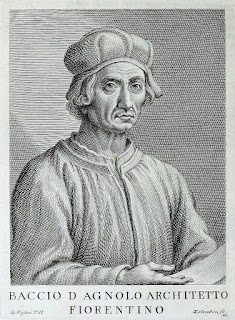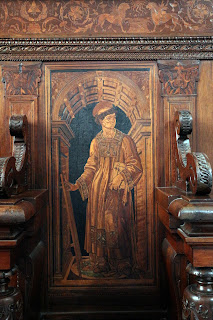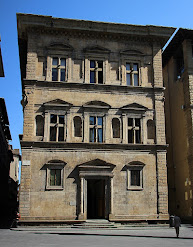Pietro Bembo – poet and scholar
Lucrezia Borgia’s lover helped with the development of modern Italian
Pietro Bembo, a writer who was influential in the development of the Italian language, was born on this day in 1470 in Venice. He is probably most remembered for having an affair with Lucrezia Borgia while she was married to the Duke of Ferrara and he was living at the Este Court with them. His love letters to her were described by the English poet, Lord Byron, centuries later, as ‘the prettiest love letters in the world.’ As a boy, Bembo visited Florence with his father where he acquired a love for the Tuscan form of Italian which he was later to use as his literary medium. He later learnt Greek and went to study at the University of Padua. He spent two years at the Este Court in Ferrara where he wrote poetry that was reminiscent of Boccaccio and Petrarch. It was when he returned to the court at Ferrara a few years later that he had an affair with Lucrezia Borgia, the daughter of Pope Alexander VI, who was at that time the wife of Alfonso I d’Este. The love letters between the pair to which Byron referred are now in the collection of the Biblioteca Ambrosiana in Milan. Byron greatly admired them when he saw them there in 1816. Read more…
_______________________________________
Ondina Valla - ground-breaking athlete
Italy’s first female Olympic champion
Trebisonda ‘Ondina’ Valla, the first Italian woman to win an Olympic gold medal, was born on this day in 1916 in Bologna. Known as Ondina reputedly after a journalist misspelled her unusual name, Valla won the 80m at the 1936 Olympics in Berlin, where she also set a world record time in the semi-final. The victory established Valla as an icon for Italy’s Fascist regime and as a heroine for Italian girls with sporting ambitions, her success breaking new ground for women in the face of considerable opposition to female participation in sport. The Catholic Church’s attitude was that sport was not compatible with the standards of morality, modesty and domesticity they expected of women, while the view of Italy’s medical profession was that women should take only basic physical exercise if they wanted to maintain the level of health required for motherhood. Benito Mussolini initially saw women as occupying a traditional role in the society he envisaged for the fascist ideal, supporting their husbands and caring for their children within the family unit. But he seized upon Valla’s success as a political opportunity, keen to portray her as an example of Italian Fascism’s dynamism and the potential for Italians to make their mark internationally. Read more...
_______________________________________
Prolific painter left a rich legacy of religious canvases
Late Renaissance painter Giovanni Paolo Cavagna, who became famous for his religious scenes, died on this day in 1627 in his native city of Bergamo. Cavagna was mainly active in Bergamo and Brescia, another historic city in the Lombardy region, for most of his career, although he is believed to have spent some time training in Venice in the studio of Titian. The artist was born in Borgo di San Leonardo in Bergamo’s Città Bassa in about 1550. The painter Cristoforo Baschenis Il Vecchio is believed to have taken him as an apprentice from the age of 12. Cavagna is also thought to have spent time as a pupil of the famous Bergamo portrait painter Giovanni Battista Moroni. Cavagna’s work can still be seen in many churches in Bergamo and villages in the surrounding area. In the Basilica of Santa Maria Maggiore in Bergamo’s Città Alta there are paintings by him of the Assumption of the Virgin, the Nativity, and Esther and Ahasuerus. In the Church of Santa Spirito in Bergamo’s Città Bassa, there are his paintings of Santa Lucia and the Crucifixion with Saints. He painted a Coronation of the Virgin for the Church of San Giovanni Battista in the province of Casnigo. Read more…
______________________________________
Albano Carrisi - singer
Performer best known as Al Bano has sold 165 million records
The singer Albano Carrisi, better known as Al Bano, was born on this day in 1943 in Cellino San Marco, a town in Puglia about 30km (19 miles) from Lecce. He enjoyed considerable success as a solo artist in the late 1960s but became more famous still in Italy and across mainland Europe for his collaboration with the American singer Romina Power – daughter of the actor Tyrone Power. They met during the shooting of a film - one of several, mainly romantic comedies and a vehicle for his songs, in which he starred during the 1970s. They not only formed a professional partnership but were married for almost 30 years. They twice performed as Italy’s entry for the Eurovision Song Contest, finishing seventh on both occasions, and appeared several times at Italy’s prestigious Sanremo Music Festival, winning the top prize in 1984. They divorced in 1999 but reunited on a professional basis in 2013 and when they performed at the Arena di Verona in 2015 before a sell-out crowd of 11,000 the show was broadcast by the Italian TV network Rai and shown in seven other countries, with a combined audience estimated at 51 million. Read more…
_____________________________________
Gabriele Muccino - film director
Enjoyed box office success in US after partnering with Will Smith
The film director Gabriele Muccino, whose best-known work so far has been the Oscar-nominated 2006 Will Smith movie The Pursuit of Happyness, was born on this day in 1967 in Rome. He is the older brother of the actor, Silvio Muccino. Muccino, who also directed Smith in Seven Pounds (2008), spent several years in Hollywood following his success in Italy with L’ultimo bacio (The Last Kiss), which won him a David Di Donatello award as Best Director and for Best Screenplay. His most recent work has been in Italy, with his latest film, Gli anni più belli (The Most Beautiful Years) released in February 2020. The son of Luigi Muccino, an executive at the state television company Rai, and painter and costume designer Antonella Cappuccio, Gabriele enrolled at Rome’s Sapienza University to study literature, but was already fascinated with the cinema. Indeed, he abandoned his studies soon after he began them, choosing instead to attend Rome’s renowned Centro sperimentale di cinematografia, where he worked unpaid as a director’s assistant, working with the highly-regarded Pupi Avati and Marco Risi. Read more…
____________________________________
Hieronymus Fabricius - anatomist and surgeon
Research pioneer known as “Father of Embryology”
The pioneering anatomist and physiologist known in academic history as Hieronymus Fabricius, whose Italian name was Girolamo Fabrizio, was born on this day in 1537 in Acquapendente, in Lazio. Fabrizio, who designed the first permanent theatre for public anatomical dissections, advanced the knowledge of the make-up of the human body in many areas, including the digestive system, the eyes and ears, and the veins. But his most significant discoveries were in embryology. He investigated the foetal development of many animals and humans and produced the first detailed description of the placenta. For this he became known as the "Father of Embryology". Fabrizio spent most of his life at the University of Padua, where he was a student under the guidance of Gabriele Falloppio, who discovered the tube connecting the ovaries with the uterus that became known as the Fallopian tube. He succeeded Falloppio as chair of surgery and anatomy, holding the post from 1562 to 1613 and building a reputation that attracted students from all of Europe. Among his pupils were the English anatomist William Harvey, as well as Giulio Casseri and Adriaan van den Spiegel, both of whom went on to become significant anatomists. Read more…
_____________________________________
Book of the Day: Pietro Bembo: A Life in Laurels and Scarlet, by Marco Faini
Pietro Bembo was both witness and participant at the centre of the Italian Renaissance. A celebrated writer, an antiquarian, a man of exquisite taste, and a lover of women and beauty, he was to win both the laurels of a poet and the scarlet robes of a Cardinal. Born in Venice, he travelled to and resided in nearly all the Italian courts, from Lorenzo il Magnifico’s Florence to Ferrara, Urbino and Rome. As Latin secretary to Pope Leo X and a lover of Lucrezia Borgia, with whom he exchanged passionate letters in great secrecy, he was an intimate of both the Medicis and the Borgias. His public writing set the style of Italian literary language, and his appreciations of Dante and Petrarch were influential across the whole of Europe. A patron and friend of many of the most refined artists of the Renaissance, from Raphael to Cellini, Bembo also lived through an age of scientific enquiry — as a boy, he was fascinated with the volcanic processes of Mount Etna — and the dawn of print culture, in which he also played a role as one of the first contemporary writers to be printed in movable type. A Life in Laurels and Scarlet, commissioned by the Fondation Barbier-Mueller pour l’étude de la poésie italienne de la Renaissance, aims to recapture, for a general readership, Bembo’s unique experience during the most glorious and tormented years of the Italian Renaissance.Marco Faini is Assistant Professor of Italian at the University at Buffalo (SUNY). He is the co-editor of A Companion to Pietro Aretino (with Paola Ugolini) and the author of Standing at the Crossroads. Stories of Doubt in Renaissance Italy.
.jpg)
.jpg)






.jpg)
.jpg)











